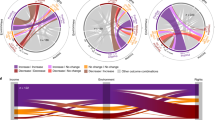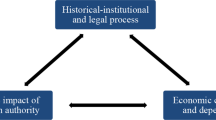Abstract
The experience with Joint Forest Management (JFM) in different countries has varied considerably, succeeding in limiting deterioration of the forest in some cases but not in others. Inequality within the forest community has also had a tendency to increase. The purposes of this chapter are (1) to review relevant literature on JFM, (2) to develop a multi-purpose model that could be used to identify conditions that can influence the likelihood of success of JFM in improving the welfare of those living and working in forest communities as well as making forest use more sustainable, and (3) to highlight the role of forest externalities and institutional conditions in analyzing the effects of JFM, and (4) to suggest applications and extensions that could provide valid policy implications tailored to specific circumstances. Although highly simplified, the model is designed so as to be flexible enough to deal with a wide variety of settings in rural areas of developing countries and yet at the same time specific enough to provide some policy conclusions. Even the present highly simplified model demonstrates general conclusions about the efficacy of JFM cannot be drawn without very specific empirical knowledge concerning the behavioral and technological parameters in the model.
Access this chapter
Tax calculation will be finalised at checkout
Purchases are for personal use only
Preview
Unable to display preview. Download preview PDF.
Similar content being viewed by others
References
Agrawal, A., & Ostrom, E. (2001). Collective action, property rights, and decentralization in resource use in India and Nepal. Politics and Society, 29(4), 485–514.
Baland, J., Bardhan, P., & Bowles, S. (Eds.) (2001). Inequality, collective action and environmental sustainability. Forthcoming: under review Princeton University Press and Russell Sage Foundation. Available electronically at: http://discuss.santafe.edu/sustainability/papers
Baland, J., & Platteau, J. (1996). Halting degradation of natural resources: Is there a role for rural communities? New York: Oxford University Press.
Baland, J., & Platteau, J. (1997). Wealth inequality and efficiency in the commons. Part I: The unregulated case. Oxford Economic Papers, 49, 451–482
Baland, J., & Platteau, J. (2001). Collective action on the commons: The role of inequality. In J. Baland, P. Bardhan, S. Bowles (Eds.), Inequality, collective action and environmental sustainability. Forthcoming: under review Princeton University Press and Russell Sage Foundation. Available electronically at: http: //discuss.santafe.edu/sustainability/papers
Bardhan, P. (2002). Decentralization of governance in development. Journal of Economic Perspectives, 16(4), 185–205.
Becker, C. D., & Leon, R. (1998). Indigenous forest management in the Bolivian Amazon: Lessons from the Yuracare people. Working Paper, CIPEC. Available electronically at: http: //dlc.dlib.indiana.edu/documents/dir0/00/00/00/17/dlc-00000017-00/becker.pdf.
Binswanger, H.P. (1991). Brazilian policies that encourage deforestation in the Amazon. World Development, 19(7), 821–829.
Bromley, D.W., & Chapagain, D.P. (1984). The village against the center: Resource depletion in South Asia. American Journal of Agricultural Economics, 66, 868–873.
Bulte, E., & Horan, R.D. (2003). Habitat conservation, wildlife extraction, and agricultural expansion. Journal of Environmental Economics, 45, 109–127.
Cardenas, J. (2003). Real wealth and experimental cooperation: Experiments in the field lab. Journal of Development Economics, 70, 263–289.
Cardenas, J., Stranlund, J., & Willis, C. (2000). Local environmental control and institutional crowding out. World Development, 28(10), 1719–1733.
Casari, M., & Plott, C.R. (2003). Decentralized management of common property resources: Experiments with a centuries-old institution. Journal of Economic Behavior and Organization, 51, 217–247.
Chakraborty, R.N. (2001). Stability and outcomes of common property institutions in forestry: Evidence from the Terai region of Nepal. Ecological Economics, 36(2), 341–353.
Edmonds, E. (2002). Government-initiated community resource management and local resource extraction from Nepal’s forests. Journal of Development Economics, 68, 89–115.
Gebremedhin, B., Pender, J., & Tesfay, G. (2003). Community natural resource management: The case of woodlots in Northern Ethiopia. Environment and Development Economics, 8, 129–148.
Hackett, S., Schlager, E., & Walker, J. (1994). The role of communication in resolving commons dilemmas: Experimental evidence with heterogeneous expropriators. Journal of Environmental Economics and Management, 27, 99–126 and reprinted in J. Shogren (Ed.), Experiments in Environmental Economics, 2003. Vermont: Ashgate Publishing Limited.
Hoffman, E., McCabe, K., Shachat, K., & Smith, V. (1994). Preferences, property rights, and anonymity in bargaining games. Games and Economic Behavior, 7, 346–380.
Hyde, W.F., Belcher, B., & Xu, J. (Eds.) (2003). China’s forests: Global lessons and market reforms. Washington, D.C.: Resources for the Future.
Jaramillo, C., & Kelly, T. (2000). Deforestation and property rights over rural land in Latin America. In K. Keipi (Ed.) Forest Resource Policy in Latin America, 2000. Washington DC: Inter-American Development Bank. Available electronically at: http://www.iadb.org/sds/doc/1411eng.pdf.
Kant, S. (2000). A dynamic approach to forest regimes in developing economies. Ecological Economics, 32, 287–300.
Kant, S., & Berry, A. (1998). Community management: An optimal resource regime for tropical forests. Working Paper UT-ECIPA-BERRY-98-01, Department of Economics, University of Toronto. Available electronically at: http: //www.economics.utoronto.ca/ecipa/archive/UT-ECIPA-BERRY-98-01.pdf
Kant, S., & Berry, A (2001). A theoretical model of optimal forest resource regimes in developing economies. Journal of Institutional and Theoretical Economics, 157(2), 331–355.
Kenneth, R. (1989). Solving the common-property dillemma: Village fisheries rights in Japanese coastal waters. In F. Berkes (Ed.), Common property resources: Ecology and community-based sustainable development. London: Belhaven Press.
Klooster, D. (2000). Institutional choice, community, and struggle: A case study of forest co-management in Mexico. World Development, (28)1, 1–20
Kruse, J., Klein, D., Braund, S., Moorehead, L., & Simeone, B. (1998). Co-management of natural resources: A comparison of two management systems. Human Organization, 57(4), 447–458.
Kumar, S. (2002). Does participation’ in common pool resource management help the poor? A social cost-benefit analysis of Joint Forest Management in Jharkhand, India. World Development, 30(5), 763–782.
Liu, D., & Edmunds, D. (2003). Devolution as a means of expanding local forest management in south China: Lessons from the past 20 years. In W.F. Hyde, B. Belcher, J. Xu (Eds.), China’s forests: Global lessons and market reforms (pp. 27–44). Washington, D.C.: Resources for the Future.
Marks, S.V. (2002). NTT sandalwood: Roots of disaster. Bulletin of Indonesian Economic Studies 38,(2), 223–240.
Munoz-Pina, C., de Janvry, A., & Sadoulet, E. (2002). Recrafting rights over common property resources in Mexico: Divide, incorporate, and equalize. Working Paper, University of California, Berkeley. Available electronically at: http://are.berkeley.edu/~sadoulet/papers/CarlosEDCC.pdf
Olson, M. (1962). The logic of collective action. Cambridge: Harvard University Press.
Ostmann, A. (1998). External control may destroy the commons. Rationality and Society, 10(1), 103–122.
Ostrom, E. (1990). Governing the commons: The evolution of institutions for collective action. Cambridge: Cambridge University Press.
Ostrom, E. (1999). Coping with tragedies of the commons. Annual Review of Political Science, 2, 493–535.
Ostrom, E., Walker, J., & Gardner, R. (1992). Covenants with and without a sword: Self-governance is possible. American Political Science Review, 86(2), 404–417.
Palfrey, T.R., & Rosenthal, H. (1994). Repeated play, Cooperation and coordination: An experimental study. Review of Economic Studies, 61, 803–836.
Platteau, J. (2001). Community-based development in the context of within group heterogeneity. In J. Baland, P. Bardhan, S. Bowles (Eds.), Inequality, collective action and environmental sustainability. Forthcoming: under review Princeton University Press and Russell Sage Foundation. Available electronically at: http: //discuss.santafe.edu/sustainability/papers
Repetto, R., & Gillis, M. (1988). Government policies and the misuse of forest resources. Cambridge: Cambridge University Press.
Richards, M. (2000). “Can sustainable tropical forestry be made profitable? The potential limitations of innovative incentive mechanisms. World Development, 28(6), 1001–1016.
Rozelle, S., Huang, J., & Benziger, V. (2003). Forest exploitation and protection in reform China: Assessing the impacts of policy and economic growth. In W.F. Hyde, B. Belcher, J. Xu (Eds.), China’s forests: Global lessons and market reforms (pp. 109–134). Washington, D.C.: Resources for the Future.
Rusnack, G. (1997). Co-management of natural resources in Canada: A review of concepts and case studies. Working Paper. Managing Natural Resources in Latin America and the Caribbean, IDRC, Ottawa.
Smith R. (2000). Community-based resource control and management in Amazonia: A research initiative to identify conditioning factors for positive outcomes. Available electronically at: http: //dlc.dlib.indiana.edu/archive/00000352/00/smithr041000.pdf
Varughese, G., & Ostrom, E. (2001). The contested role of heterogeneity in collective action: Some evidence from community forestry in Nepal. World Development, 29(3), 747–765.
Walker, J.M., Gardner, Herr, A., & Ostrom, E. (2000). Collective choice in the commons: Experimental results on proposed allocation rules and votes. The Economic Journal, 110, 212–234.
Zhang, Y., Uusivuori, J., Kuuluvainen, J., & Kant, S. (2003). Deforestation and reforestation in Hanan: Roles of markets and institutions. In W.F. Hyde, B. Belcher, J. Xu (Eds.), China’s forests: Global lessons and market reforms (pp. 135–150). Washington, D.C.: Resources for the Future.
Author information
Authors and Affiliations
Editor information
Editors and Affiliations
Rights and permissions
Copyright information
© 2005 Springer
About this chapter
Cite this chapter
Chakrabarti, M., Datta, S.K., Howe, E.L., Nugent, J.B. (2005). Joint Forest Management: Experience and Modeling. In: Kant, S., Berry, R.A. (eds) Economics, Sustainability, and Natural Resources. Sustainability, Economics, and Natural Resources, vol 1. Springer, Dordrecht. https://doi.org/10.1007/1-4020-3518-7_11
Download citation
DOI: https://doi.org/10.1007/1-4020-3518-7_11
Publisher Name: Springer, Dordrecht
Print ISBN: 978-1-4020-3465-7
Online ISBN: 978-1-4020-3518-0
eBook Packages: Earth and Environmental ScienceEarth and Environmental Science (R0)




